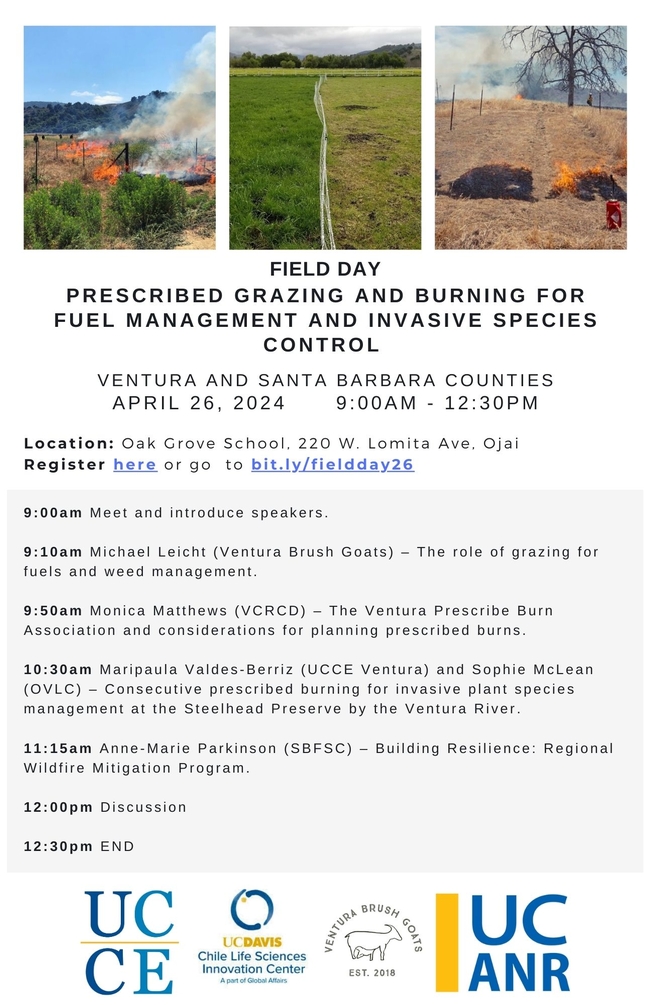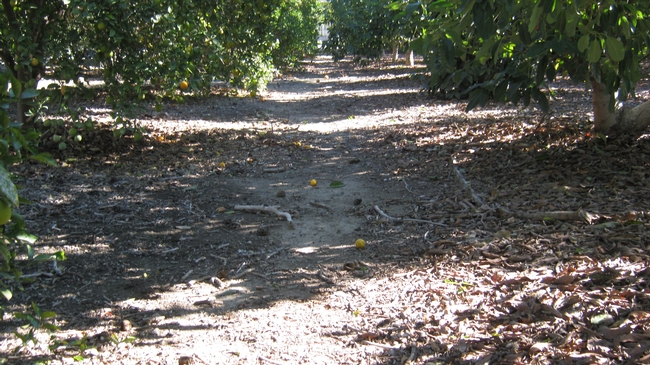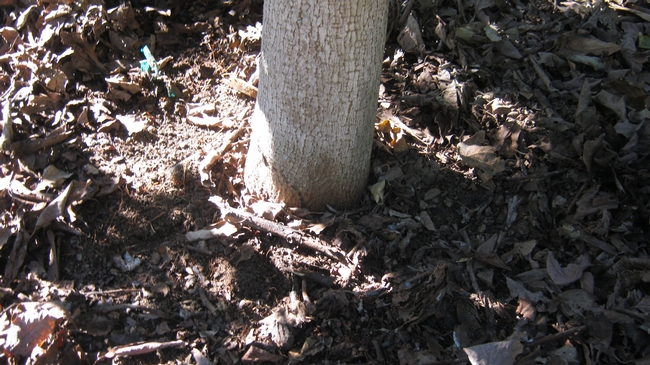
Posts Tagged: fire
Fire in the Orchard
The very fact that avocados can be grown in hard to get to places means that the trees are also in areas that are subject to wildfire damage. Recently several hundred acres of avocado burned in the Fillmore/Santa Paula foothills. The fire was fanned by high winds and low humidity. And in spite of being five weeks away from the June 1 weed abatement date, the green hills burned with fury.
Every year there are avocado trees that burn, either through careless attention to early morning fires that pickers build, wildfires or car accidents. A grower needs to be patient and observant to bring the trees back into production.
Although injury to foliage and young growth is visible within a few days of the fire, the full extent of the damage may not be known for several months or possibly the next growing season. In the case of severe injury, die-back may continue to occur for several months after the fire. New growth that occurs after the fire may suddenly collapse the following year when the growth is tested by Santa Ana conditions.
The important rule to follow after a fire is to do nothing - don't prune, don't water, don't fertilize. The avocado has a tremendous ability to come back from fire and frost damage. However, the tree will tell you where it is coming back. It will start pushing growth where the tree is still healthy. It may take 3 to 6 months for this growth to occur.
Delay pruning until the tree clearly shows where it is going to regrow. By waiting, you save the expense of having to return sometime later to remove more wood and also will be able to save the maximum about of tree.
In the meantime, if the tree has been defoliated by the fire, it has lost its ability to transpire water. Watering a tree with no leaves, will set up those conditions that are conducive to root rot. Until the tree begins to leaf out, the emitters should be capped or plugged. Then as the tree puts on new growth, shallow, infrequent irrigations should start. This may mean replacing the 10 gph microsprinkler with a 1 gph dripper if only a portion of the orchard has been burned and the rest of the trees need their usual amounts and frequency of water.
An activity the grower can perform is whitewashing. The defoliated tree can be further damaged by sunburn after it has lost its protective cover of leaves. The upper surface of horizontal limbs and the south sides of exposed trunks are the most affected. The whitewash can delay the appearance of new growth, but it does not affect total growth. There is usually no value in applying the whitewash to small limbs.
There are various commercial whitewashes on the market or one can be prepared by mixing 50 pounds of hydrated lime and 100 gallons of water. The easiest to prepare is the cheapest latex paint on the market mixed with water to the extent that it will go through a sprayer.
Avocado trees have a great ability to recover after fire damage. Even trees killed below the bud union will frequently develop into good trees if they are rebudded and given good care. Trees which do not put out vigorous sprouts should be removed. Interplanting avocados would rarely be advisable because of their rapid recovery. Think of fire as an advanced pruning plan.

fire coming into orchard
Wild Fire and Soil
Low-severity wildland fires and prescribed burns have long been presumed by scientists and resource managers to be harmless to soils, but this may not be the case, new research shows.
According to two new studies by a team from the University of California, Merced (UCM) and the Desert Research Institute (DRI), low-severity burns - in which fire moves quickly and soil temperature does not exceed 250oC (482oF) - cause damage to soil structure and organic matter in ways that are not immediately apparent after a fire.
"When you have a high-severity fire, you burn off the organic matter from the soil and the impact is immediate," said Teamrat Ghezzehei, Ph.D., principal investigator of the two studies and Associate Professor of Environmental Soil Physics at UCM. "In a low-severity fire, the organic matter doesn't burn off, and there is no visible destruction right away. But the burning weakens the soil structure, and unless you come back at a later time and carefully look at the soil, you wouldn't notice the damage."
DRI researcher Markus Berli, Ph.D., Associate Research Professor of Environmental Science, became interested in studying this phenomenon while visiting a burned area near Ely, Nev. in 2009, where he made the unexpected observation that a prescribed, low-severity fire had resulted in soil structure damage in the burned area. He and several colleagues from DRI conducted a follow-up study on another controlled burn in the area, and found that soil structure that appeared to be fine immediately after a fire but deteriorated over the weeks and months that followed. Berli then teamed up with Ghezzehei and a team from UCM that included graduate student Mathew Jian, and Associate Professor Asmeret Asefaw Berhe, Ph.D., to further investigate.
Soil consists of large and small mineral particles (gravel, sand, silt, and clay) which are bound together by organic matter, water and other materials to form aggregates. When soil aggregates are exposed to severe fires, the organic matter burns, altering the physical structure of the soil and increasing the risk of erosion in burned areas. In low-severity burn areas where organic matter doesn't experience significant losses, the team wondered if the soil structure was being degraded by another process, such as by the boiling of water held within soil aggregates?
In a study published in AGU Geophysical Research Letters in May 2018, the UCM-DRI team investigated this question, using soil samples from an unburned forest area in Mariposa County, Calif. and from unburned shrubland in Clark County, Nev. to analyze the impacts of low-severity fires on soil structure. They heated soil aggregates to temperatures that simulated the conditions of a low-severity fire (175oC/347oF) over a 15-minute period, then looked for changes in the soil's internal pore pressure and tensile strength (the force required to pull the aggregate apart).
During the experiment, they observed that pore pressure within the soil aggregates rose to a peak as water boiled and vaporized, then dropped as the bonds in the soil aggregates broke and vapor escaped. Tensile strength measurements showed that the wetter soil aggregates had been weakened more than drier soil samples during this process.
"Our results show that the heat produced by low-severity fires is actually enough to do damage to soil structure, and that the damage is worse if the soils are wet," Berli explained. "This is important information for resource managers because it implies that prescribed burns and other fires that occur during wetter times of year may be more harmful to soils than fires that occur during dry times."Next, the research team wondered what the impact of this structural degradation was on the organic matter that the soil structure normally protects. Soil organic matter consists primarily of microbes and decomposing plant tissue, and contributes to the overall stability and water-holding capacity of soils.
In a second study that was published in Frontiers in Environmental Science in late July, the UCM-DRI research team conducted simulated burn experiments to weaken the structure of the soil aggregates, and tested the soils for changes in quality and quantity of several types of organic matter over a 70-day period.
They found that heating of soils led to the release of organic carbon into the atmosphere as CO2 during the weeks and months after the fire, and again found that the highest levels of degradation occurred in soils that were moist. This loss of organic carbon is important for several reasons, Ghezzehei explained.
"The loss of organic matter from soil to the atmosphere directly contributes to climate change, because that carbon is released as CO2," Ghezzehei said. "Organic matter that is lost due to fires is also the most important reserve of nutrients for soil micro-organisms, and it is the glue that holds soil aggregates together. Once you lose the structure, there are a lot of other things that happen. For example, infiltration becomes slower, you get more runoff, you have erosion."
Although the research team's findings showed several detrimental effects of fire on soils, low-severity wildfires and prescribed burns are known to benefit ecosystems in other ways -- recycling nutrients back into the soil and getting rid of overgrown vegetation, for example. It is not yet clear whether the negative impacts on soil associated with these low-severity fires outweigh the positives, Berli says, but the team hopes that their research results will help to inform land managers as they manage wildfires and plan prescribed burns.
"There is very little fuel in arid and semi-arid areas, and thus fires tend to be short lived and relatively low in peak temperature," Ghezzehei said. "In contrast to the hot fires and that burn for days and weeks that we see in the news, these seem to be benign and we usually treat them as such. Our work shows that low-severity fires are not as harmless as they may appear."
The study, "Soil Structural Degradation During Low?Severity Burns," was published on May 31, 2018 in the journal AGU Geophysical Research Letters and is available here: https:/
The study, "Vulnerability of Physically Protected Soil Organic Carbon to Loss Under Low Severity Fires," was published July 19, 2018 in the journal Frontiers in Environmental Science, and is available here: https:/

IMG 2031
Fire Information for Tree Crop Growers
The following is a compendium of blogs for growers to help with the recent fire damage in the Ventura area:
Tree and Vine Loss Calculators
Spread sheets to help you calculate loss
Calculate Cost of Fire Damage to Avocado and Citrus Trees
Information from Ben Faber, Soils and Water, Avocado and Minor Subtropicals Advisor
Information on how to care for fire damaged trees from Ben Faber, Soils and Water, Avocado and Minor Subtropicals Advisor
Information on fire ecology and fire safe landscaping for homeowners, developed by Sabrina Drill, Natural Resources Advisor
UC Center for Fire Research and Outreach
Information on fire science from UC experts. Includes information on how to make homes and other structures more fire re
Publications Available From University of California ANR Catalog
You can find the publications listed below at the University of California DANR Catalog site (In the ANR Search type fire) and order more than one publication at a time or you may click on one of the links below. if you purchase a priced publication enter the promotion code PRVEN56 at check-out. You'll receive a 10% discount on your order, and a portion of the sales will benefit local programs.
A Property Owner's Guide to Reducing Wildfire Threat - describes ways homeowners can reduce the threat of fire to their property. Cost $1.50
Home Landscaping for Fire - Incorporating fire safe concepts into your landscape is one of the most important ways you can help your home survive a wildfire. FREE
Landscaping Tips to Help Defend Your Home from Wildfire - You can have both a beautiful landscape and a defensible fire-safe zone. FREE
Recovering from Wildfire - discusses issues that family forest landowners should consider following a wildfire. Cost $5.00
WildFire: How Can We Live With It? (DVD) - This program contains general information about wildland fire in California. Cost $20.00
Companion Set: How Can We Live with Wildland Fire? (Publication and DVD) - What role does fire play in the natural cycle and what choices can we make about coping with wildland fire? Cost $27.50
How Can We Live with Wildland Fire? - What role does fire play in the natural cycle and what choices can we make about coping with wildland fire? Cost $10.00
Don't hesitate to contact me, at
805-645-1462
bafaber@ucanr.edu

IMG 2040
Using Fire as a Management Tool, Prescribed Grazing Too
Fire Around Avocados
A great idea from Ed McFadden of Philmore or Fillmore in the local language.
You can always do something to prevent or correct the Big 4 that seem to strike avocados on a regular basis somewhere in California. Avocados in the back country are right up against areas that can burn easily. A fast fire can send embers into an orchard which can burn through the thick leaves in a slow burn. If it gets up against leaves piled up against the trunk, it can girdle the tree, killing it. The slow burn can continue through the orchard torching the irrigation lines. With a small fire break where the leaves are removed in a small alley, the burn can be slowed or stopped.
Leaves are great for erosion control, for nutrient cycling and disease control, but if they mean increasing potential for fire spread, it's a good idea to remove a little of it. Ed has found that a backpack blower can rapidly remove leaves from around the base of trees and create a narrow fire break that can reduce fire damage to trees.
Avocado orchards are notable for their ability to actually reduce fire hazard and slow major fires as has been shown in fires in San Diego, Ventura and Santa Barbara. This is partly due to running sprinklers during wild fire. But tree loss can still occur, especially when electricity goes down and pumps can't run.
Little rain this year or too much rain this year can always pose a hazard to avocado orchards. This sure seems like a good idea to me. And maybe it's time to start thinking about fire season now.
Photos: Cleared alley and trunk.
And another observation from 2008
And orchards being recognized as valuable in a fire prone area by the Santa Barbara Fire Safe Council
Orchards are another fire mitigation strategy, one that has already benefitted Goleta but has played a lesser role for Santa Barbara and Montecito where fewer orchards now exist. More orchards could be planted
The fire burned in the hills until July 28, blackending nearly 10,000 acres but causing relatively little structural damage. Firefighters credited the agricultural barrier of green avocado orchards and irrigated soil surrounding Goleta with saving the town.
But most importantly, how to prepare for fire. Read ON

fire in the distance



